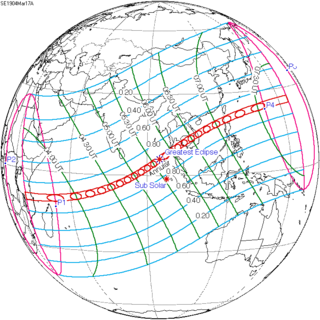| Solar eclipse of March 17, 1904 | |
|---|---|
| Type of eclipse | |
| Nature | Annular |
| Gamma | 0.1299 |
| Magnitude | 0.9367 |
| Maximum eclipse | |
| Duration | 487 s (8 min 7 s) |
| Coordinates | 5°36′N 94°42′E / 5.6°N 94.7°E |
| Max. width of band | 237 km (147 mi) |
| Times (UTC) | |
| Greatest eclipse | 5:40:44 |
| References | |
| Saros | 128 (52 of 73) |
| Catalog # (SE5000) | 9290 |
An annular solar eclipse occurred at the Moon's descending node of orbit on Thursday, March 17, 1904,[1][2][3][4][5] with a magnitude of 0.9367. A solar eclipse occurs when the Moon passes between Earth and the Sun, thereby totally or partly obscuring the image of the Sun for a viewer on Earth. An annular solar eclipse occurs when the Moon's apparent diameter is smaller than the Sun's, blocking most of the Sun's light and causing the Sun to look like an annulus (ring). An annular eclipse appears as a partial eclipse over a region of the Earth thousands of kilometres wide. Occurring only about 3 days after apogee (on March 14, 1904, at 6:00 UTC), the Moon's apparent diameter was smaller.[6]
The path of annularity covered southern German East Africa (now southern Tanzania), northeastern tip of Portuguese East Africa (now Mozambique), northern Grande Comore Island in French Comoros (now Comoros), southern British Seychelles (now Seychelles), British Mauritius (now Mauritius), most of the British Indian Ocean Territory (excluding the southern part of Diego Garcia), northwestern Sumatra in the Dutch East Indies (now Indonesia), southern Siam (now renamed as Thailand), French Indochina (the part now belonging to Cambodia, the southern tip of Laos and southern Vietnam, including the major city Phnom Penh, now capital of Cambodia), all of the Paracel Islands, the northern tip of the American Philippines (now Philippines) and Japanese islands of Iwo Jima, South Iwo Jima and Minamitorishima.
In addition, a partial solar eclipse was seen within a much larger area, including the eastern half of Africa, southern West Asia, southern Afghanistan, South Asia except the northernmost tip of British Raj (now the northernmost tip of Pakistan), most of China except the northwest border, Korean Peninsula, Japan, Southeast Asia, the extreme northern coast of Australia, northwestern Melanesia, central and western Micronesia, and southeastern Russian Empire.
- ^ "March 17, 1904 Total Solar Eclipse". timeanddate. Retrieved 30 July 2024.
- ^ "THIS ECLIPSE SKIPS AMERICUS". Americus Times-Recorder. Americus, Georgia. 1904-03-17. p. 4. Retrieved 2023-10-27 – via Newspapers.com.
- ^ "An eclipse of the sun". The Kansas City Star. Kansas City, Missouri. 1904-03-17. p. 3. Retrieved 2023-10-27 – via Newspapers.com.
- ^ "ERIN GO BRAUGH". The Daily Journal. Freeport, Illinois. 1904-03-17. p. 4. Retrieved 2023-10-27 – via Newspapers.com.
- ^ "Sun to be eclipsed today". The Brunswick News. Brunswick, Georgia. 1904-03-17. p. 1. Retrieved 2023-10-27 – via Newspapers.com.
- ^ "Moon Distances for London, United Kingdom, England". timeanddate. Retrieved 30 July 2024.
